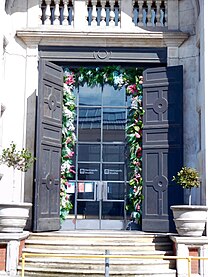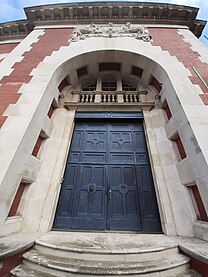
Pitsford is a village and civil parish in West Northamptonshire in the United Kingdom. According to 2001 census, the parish's population was 636 people, increasing to 671 at the 2011 census.
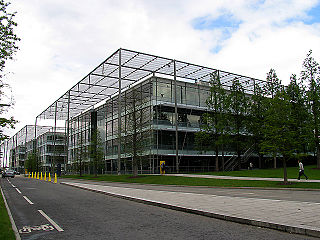
Chiswick Business Park is a business park in Gunnersbury, West London, fronting on to Chiswick High Road.

Wright's Flour Mill is located in Wharf Road, Ponders End, Enfield. It is Enfield's oldest working industrial building.
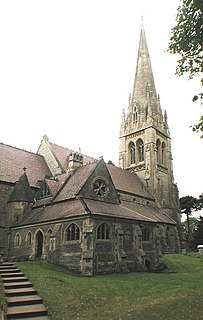
Henry Woodyer (1816–1896) was an English architect, a pupil of William Butterfield and a disciple of A. W. N. Pugin and the Ecclesiologists.
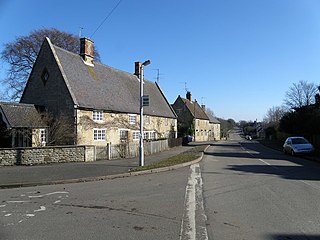
Cranford St John is an English village near Kettering in Northamptonshire. It is in the southern half of the civil parish of Cranford, next to Cranford St Andrew - both named after the two parish churches. The two settlements are divided by the Aledge Brook, a feeder to the River Ise; the derivation of the name is "ford frequented by cranes or herons".

Metropolis Studios is a music production and entertainment industry company established in 1989 by Gary Langan, Carey Taylor and Karin Clayton. It is located in the Powerhouse, a Grade II listed building, at 70 Chiswick High Road in Chiswick, London, England. Over the last twenty years the group has expanded and now consists of three divisions: Metropolis Studios, Metropolis Mastering, and Digital Media/Productions.
Acton Green is a residential neighbourhood in Chiswick and the London Borough of Ealing, in West London, England. It is named for the nearby Acton Green common. It was once home to many small laundries and was accordingly known as "Soapsuds Island".
Grove Park is an area in the south of Chiswick, now in the borough of Hounslow, West London. It lies in the meander of the Thames occupied by Duke's Meadows park. Historically, the area belonged to one of the four historic villages in modern Chiswick, Little Sutton. It was long protected from building by the regular flooding of the low-lying land by the River Thames, remaining as orchards, open fields, and riverside marshland until the 1880s. Development was stimulated by the arrival of the railway in 1849; Grove Park Hotel followed in 1867, soon followed by housing.

Kelly & Birchall, a partnership between Edward Birchall and John Kelly (1840–1904), was an architectural practice based in Leeds, England, from 1886 to 1904 and specialising in churches in the Italianate and Gothic Revival styles.

The Old Pack Horse is a Grade II listed public house in a prominent position on the corner of Chiswick High Road and Acton Lane in Chiswick, London.
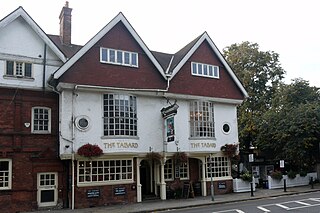
The block of three buildings containing The Tabard public house is a Grade II* listed structure in Chiswick, London. The block, with a row of seven gables in its roof, was designed by Norman Shaw in 1880 as part of the community focus of the Bedford Park garden suburb. The block contains the Bedford Park Stores, once a co-operative, and a house for the manager.
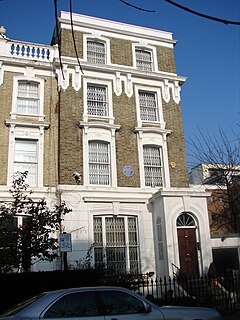
Harley Gardens is a residential street in Chelsea, London SW10. It runs roughly north to south from Priory Walk to Milborne Grove, parallel to the west of Drayton Gardens, and lies just north of Fulham Road.
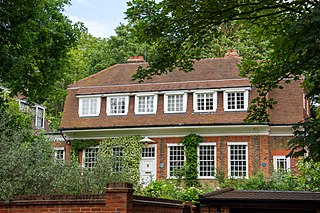
One Oak at 16 Redington Road in the Frognal area of Hampstead, London NW3, is a detached house built in 1889 by the architect Arthur Heygate Mackmurdo. The house has been listed Grade II on the National Heritage List for England since January 1999.

East Barnet Town Hall is a former municipal building in Station Road, East Barnet, London, England. The town hall, which was the headquarters of East Barnet Urban District Council, is a locally listed building.
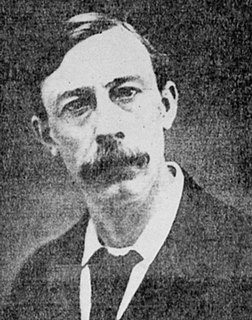
John Dixon Butler was a British architect and the Surveyor to London's Metropolitan Police from 1895 until his death. He completed the designs to around 200 buildings during his career, nearly all for the Metropolitan Police, including ten courts; as of 2022, about 58 of his buildings survive. Historic England describes him as "one of the most accomplished Metropolitan Police architects" and have included around 25 of his buildings on the National Historic List of England and Wales.

The Duke of Sussex, Acton Green is a public house, opened in 1898, in the northern Chiswick district of Acton Green. It is prominently situated on a corner facing the common. The Grade II listed building is "elaborately decorated" to a design by the pub architects Shoebridge & Rising.
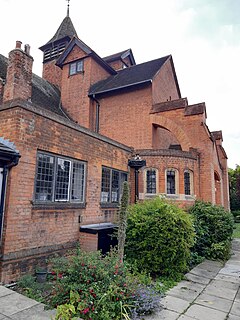
St Michael's Church, Grove Park is an Anglican church in the Grove Park district of Chiswick, opened in 1909. Its red brick architecture by W. D. Caröe & Herbert Passmore has been praised by Nikolaus Pevsner.
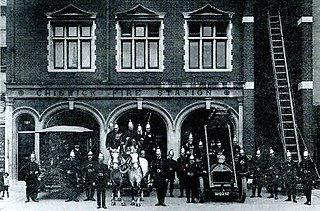
The Old Fire Station, Chiswick is an 1891 brick building with stone facings on Chiswick High Road. It served as a fire station until 1963, and has since been used as a restaurant.

Chiswick High Road is the principal shopping and dining street of Chiswick, a district in the west of London. It was part of the main Roman road running west out of London, and remained the main road until the 1950s when the A4 was built across Chiswick. By the 19th century the road through the village of Turnham Green had grand houses beside it. The road developed into a shopping centre when Chiswick became built up with new streets and housing late in the 19th century. There are several listed buildings including public houses, churches, and a former power station, built to supply electricity to the tram network.

British industrial architecture has been created, mainly from 1700 onwards, to house industries of many kinds in Britain, home of the Industrial Revolution in this period. Both the new industrial technologies and industrial architecture soon spread worldwide. As such, the architecture of surviving industrial buildings records part of the history of the modern world.





